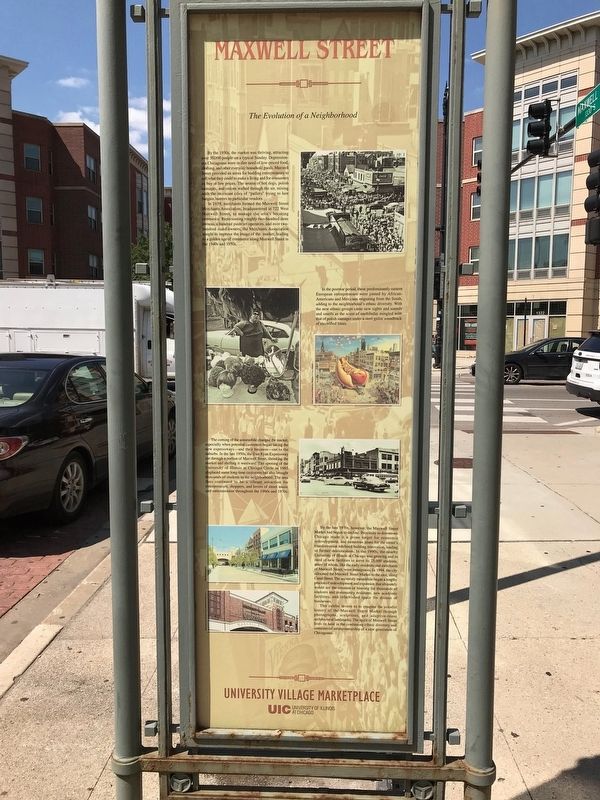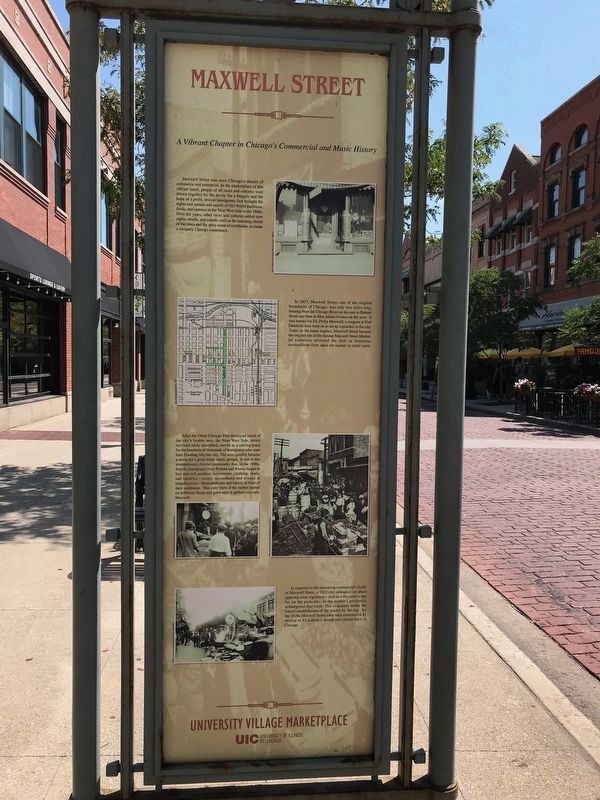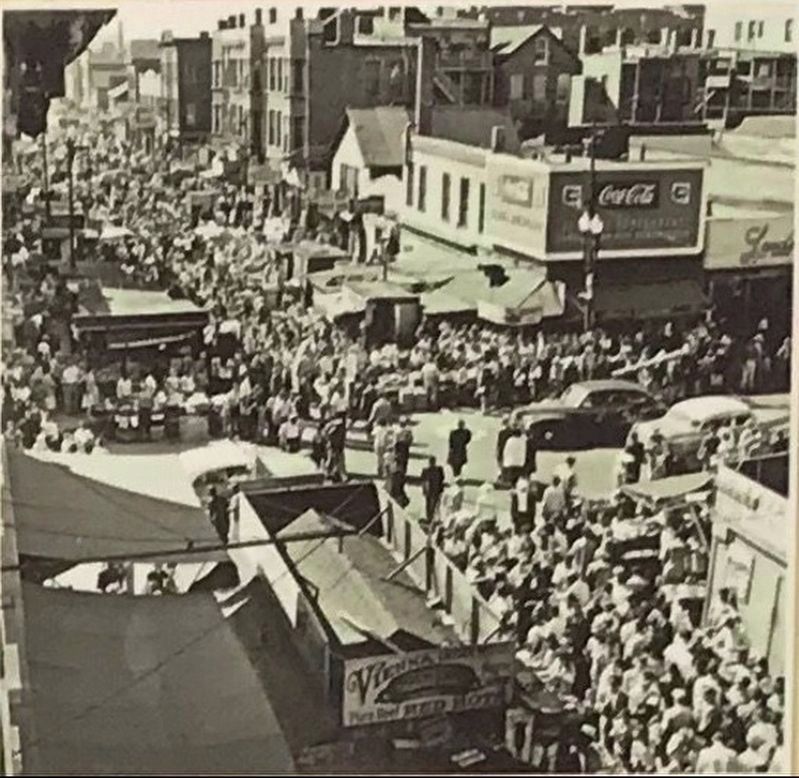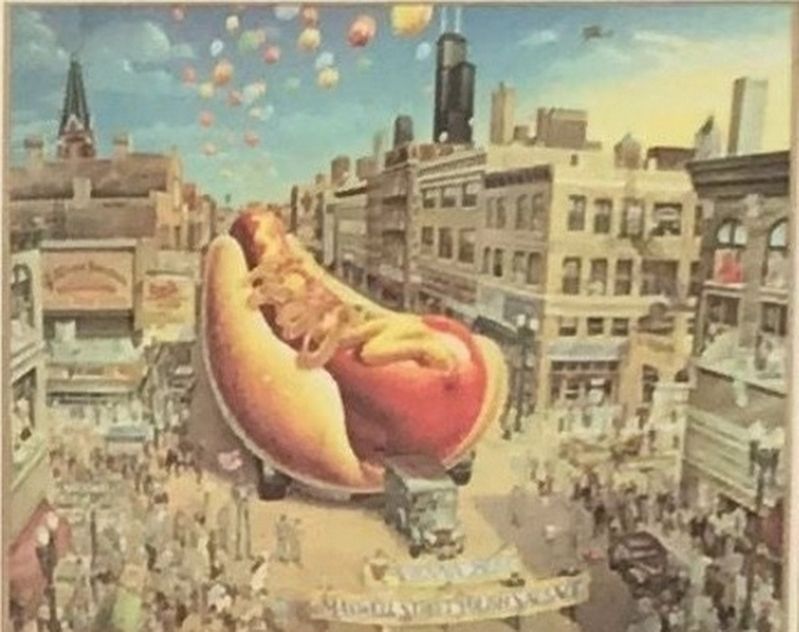Little Italy in Chicago in Cook County, Illinois — The American Midwest (Great Lakes)
Maxwell Street
Evolution of a Neighborhood
By the 1930s, the market was thriving, attracting 50,000 people on a typical Sunday. Depression-Chicagoans were in dire need of low-priced food clothing, and other everyday household goods. Maxwell Street provided an arena for budding entrepreneurs to sell what they could to make a living and for consumers to buy at low prices. The aroma of hot dogs, polish sausages, and onions wafted through the air, mixing with the incessant cries of "pullers” trying to lure bargain hunters to particular vendors.In 1939, merchants formed the Maxwell Street Merchant's Association, headquartered at 722 West Maxwell Street,to manage the area's booming commerce, Representing roughly two-hundred store owners, a hundred pushcart operators, and over two-hundred stand owners, the Merchants Association sought to improve the image of the market, leading a golden age of commerce along Maxwell Street in the 1940s and 1950s.
In the postwar period, these predominantly eastern European entrepreneurs were joined by African- Americans and Mexicans migrating from the South, adding to the neighborhood''s ethnic diversity. With the new ethnic groups came new sights and sounds and smells as the scent of enchiladas mingled with that of polish sausages under a steel-guitar soundtrack of electrified blues.
The coming of the automobile changed the market,especially when potential customers began taking the new expressways-and their business- out to the suburbs. In the late 1950s, the Dan Ryan Expressway cut through a portion of Maxwell Street, shrinking the market and shifting it westward. The opening of the University of Illinois at Chicago Circle in 1965 displaced some long-time customers but also brought thousands of students to the neighborhood. The area thus continued to be a vibrant attraction for entrepreneurs, shoppers, and lovers of street music and entertainment throughout the 1960s and 1970s.
By the late 1970s, however, the Maxwell Street Market had begun to decline. Proximity to downtown Chicago made it a prime target for economic redevelopment, and numerous plans for the street''s transformation inhibited building renovation, leading to further deterioration. In the 1990s, the nearby University of Illinois at Chicago was growing and in need of new facilities to serve its 25,000 students many of whom, like the early residents and merchants of Maxwell Street, were immigrants. In 1994, the city relocated the Maxwell Street Market to the east, along Canal Street. The university meanwhile began a lengthy process of redevelopment and expansion that ultimately would see the creation of housing for thousands of students and community residents, new academic facilities, and refurbished space for dozens of businesses. This exhibit invites us to imagine the colorful architectural landmarks. This exhibit invites us to imagine the colorful history of the Maxwell Street Market through photographs, sculptures, and adaptive-reuse architectural landmarks. The spirit of Maxwell Street lives on here in the continuing ethnic diversity and commercial entrepreneurship of a new generation of Chicagoans.
Side Two
1837, Maxwell Street, one of the original boundaries of Chicago, was only two miles long,running from the Chicago River on the east to Halsted Street and then to Blue Island Avenue on the west.It was named for Dr. Philip Maxwell, a surgeon at Fort Dearborn who went on to set up a practice in the city. Later, as the name implies, Maxwell Street became the original site of the famous Maxwell Street Market. Its evolution mirrored the shift in American mercantilism from open-air market to retail store.
After the Great Chicago Fire destroyed much of the city''s livable area, the Near West Side, which survived fairly unscathed, served as a settling place for the hundreds of thousands of immigrants who were then flooding into the city. The area quickly became a nexus for a great many ethnic groups. It was in this tremendously diverse community that, in the 1890s,Jewish immigrants from Poland and Russia began t buy and sell produce, housewares, clothing, shoes,and sundries-mostly secondhand and always at bargain prices-from pushcarts and barrels in front their residences. This early form of the market started on Jefferson Street and grew until it spilled over onto Maxwell.
In response to the increasing commercial vitality of Maxwell Street, a 1912 city ordinance set about applying some regulation-such as a ten-cents-a-day fee for the pushcarts-to the market''s previously unhampered free trade. This ordinance marks the formal establishment of the market by the city. By the 1920s, Maxwell Street sales were estimated at 1$ million to $2 million a month and ranked third in Chicago.
Erected by University Village Marketplace, University of Illinois.
Topics. This historical marker is listed in these topic lists: Entertainment • Industry & Commerce. A significant historical year for this entry is 1930.
Location. 41° 51.891′ N, 87° 38.769′ W. Marker is in Chicago, Illinois, in Cook County. It is in Little Italy. Marker is at the intersection of West Maxwell Street and Halsted, on the left when traveling east on West Maxwell Street. Touch for map. Marker is in this post office area: Chicago IL 60607, United States of America. Touch for directions.
Other nearby markers. At least 8 other markers are within one mile of this marker, measured as the crow flies. Paul Muni (approx. 0.2 miles away); Site of the Origin of the Chicago Fire of 1871 (approx. 0.4 miles away); Juvenile Court of Cook County Building (approx. half a mile away); Jane Addams' Hull-House and Dining Hall (approx. half a mile away); Jane Addams' Hull House (approx. half a mile away); Saint Frances Xavier Cabrini (approx. 0.7 miles away); St. Patrick's Church (approx. one mile away); Rowe Building (approx. one mile away). Touch for a list and map of all markers in Chicago.
Additional keywords. Immigrants, Marketplace
Credits. This page was last revised on January 30, 2023. It was originally submitted on September 2, 2018, by Steve Masler of Memphis, Tennessee. This page has been viewed 377 times since then and 38 times this year. Photos: 1, 2. submitted on September 2, 2018, by Steve Masler of Memphis, Tennessee. 3, 4. submitted on September 3, 2018, by Steve Masler of Memphis, Tennessee. • Bill Pfingsten was the editor who published this page.



